How to Find, Butcher, Cook and Serve a Fawn
Posted by James Sherrett on Wednesday, February 11th, 2009Tags for this Article: Bowen Island, butcher, deer, fawn, meat, story
“You think we could do something with it?”
That was my first clue. That was what my friend Boris Mann asked me, the day before we went to his holiday open house on Bowen Island.
‘It’ was a dead fawn. Boris and his family had discovered the fawn in the snow within steps of their back door. The fawn had succumbed to the cold and deep snow at about the same place where it had been fed apples by Boris’ mother Anna all fall. They had dragged the fawn to the back of their property and left it in the deeper snow to be eaten by whatever ate deer on Bowen Island.
We arrived by water taxi the next day around midday. I still didn’t know if we would ‘do something’ with the dead fawn.
In truth, I felt pretty unsure. ‘Doing something’ meant butchering the fawn. I was all for wild game but I didn’t know that everyone at the open house would be as open. And I didn’t have any hunting knives. I had excuses: I had never butchered a deer that wasn’t a fresh kill, I had never butchered a deer, never mind a fawn, in BC, within sight of downtown Vancouver and the birthplace of Greenpeace and all those moral vegetarians.
So when we arrived at the Mann’s place ‘doing something’ with the fawn remained a question.
The winter sun reflected off the icy snow on our trudge up from the government dock. The warm house beckoned us inside for soup, beer, bread and cheese. But first, Boris wanted to know: were we going to do something about that fawn?
We decided, before we took off our boots and outdoor gear, we were.
Boris led a group of us up the hill in their back yard to a clearing where they had dragged the fawn. We had brought a few kitchen knives, one sharp enough to cut the hide.
The fawn lay undisturbed in the snow. A few vague footprints marked the snow. A hoof stuck up. We dug into the snow and found the shape of the body by feel — cold but not frozen. It had no marks on its hide. It had not struggled or been harmed. It had just curled up and frozen.
We decided to cut it open. I won’t say too much about that part of the story. If you want to know, ask me and I’ll put together a post on how to butcher a deer (or any 4 legged mammal).
We gutted the deer and hung it to bleed. We skinned it and sawed off the head. We cut the loin off the spine, the hips off the pelvis, the front shoulder off the rib cage and sectioned the neck. We had the big pieces broken down in a big silver salad bowl. Winter dusk approached and we slid back down the hill to the house to finish the finer work in the warmth.
Someone brought a hoof with them and knocked on the patio door with it.
We brought the big cuts inside and started to think of them as venison to be cooked, no longer fawn to be butchered. Photos were taken. The story of finding the fawn quickly got told again to new arrivals wondering what we had been doing.
We started by cooking the loin. Cut into small round medallions, seasoned with salt and pepper, Boris pan fried them in duck fat. We rested them for about 3 minutes then cut then quartered each medallion and served them on a platter for people to eat them with their fingers in whole bites.
The early reviews came back positive. It was the most tender red meat anyone had ever tasted.
Next we cut the hooves from the front legs, trimmed the neck and placed them all with their bones into a large cast iron roasting pan. We added Czechoslovakian cabbage soup as braising liquid. Some red wine stood on the counter so we added it then lidded the pan and placed it in the oven at 325ish. We looked at the clock to make sure to take it out in around 3 hours.
I started trimming the roasts off the back hips. With such small hips the roasts came off closer in size to steaks than any roast from the butcher shop. I laid them out and they flattened on a cutting board. I seasoned them with salt, pepper and thyme and seared them in the pan with more duck fat.
The meat had an incredible liquid quality to it. As soon as the roasts hit the hot cast iron they tensed and shrank, like a snail retreating into its shell. So much moisture in that young meat! The moisture quickly turned to steam and a fine, savory, peppery crust formed.
We rotated the roasts through the frying pan, placing the seared ones under tin foil on a standing pan. A thick crust of seasoning remained on the bottom of the pan. I added a few cups of red wine to the pan and began to deglaze. Once all the beautiful crusty fond released from the pan I added some chopped dried fruits — apricots, cranberries and prunes — and they softened and mixed into the rich pan sauce.
By the time the wine had reduced by about three quarters, someone had handed me a can of Kokanee beer. It felt like the right beer at the right time. This was simple, blue-collar cooking that matched well to simple beer straight from the can.
I poured the reduced wine and soft fruit over the roasts on the roasting pan, tucking the bits of apricot between the meat. To make room in the oven I pulled out the braising pan with the front shoulders and neck, bumped the oven heat to 350 and slid in the roasts. They finished in about 10 minutes and rested for 5 minutes.
We sliced the roasts to serve. Across the grain of the meat we cut delicate slices of rare fawn. It was clear again that this was fawn. We plated the slices on a platter and poured over the pan juice. I snuck a few slices onto a side plate to eat with my hands. The texture felt incredible: the crusty outside yielded to a dense inside closer in texture to tuna than beef. The sweet, tart fruits finished it.
And maybe you don’t want to know this, because it was a fawn, because it was a deer that had eaten apples from Anna Mann’s hands, but that meat was about the best meat I’ve ever tasted.
Boris and his dad Horst served the roast slices straight from the roasting pan and I removed the braised front legs and neck from the oven. I pulled the legs and neck from the braising liquid to let them cool, then cranked the heat on the oven. Back in went the roasting pan with the braising liquid to concentrate.
The legs and neck cooled. I’d tell you that the meat from the bones, but I really just lifted the bones and the meat feel free. The meat was so tender and falling apart, the challenge would be to serve it in some form.
On a cookie sheet we laid out the larger pieces of meat. I removed the concentrated braising liquid from the oven and spooned portions over the meat on the cookie sheet.
Back into the oven, under the broiler for about 5 minutes, then the meat was ready — a little crusted on the outside, tender as can be on the inside. We had to use a spatula to lift it. Each portion we served over a slice of baguette to soak up the juice and provide a subtantial base. The meat just fell apart otherwise.
Somebody served that dish. I can’t remember who.
We looked around the kitchen and only 2 shanks remained. We had started with a fawn and now we had 20 people fed, groaning, happy and a few leftovers.
And I won’t lie: it felt a little triumphant. A little like we’d gotten back in touch with a way of living and eating that we only rarely touch — on camping trips or fishing trips. A little like we’d gone back in time to an age when this kind of thing wouldn’t have been less unusual.
We closed down the kitchen and started to clean up. Friends helped out and we soon had the big parts of the job done so that we could sit and open a few more Kokanees.
And the two remaining shanks? We put in them fridge for another time.
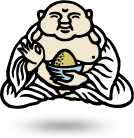
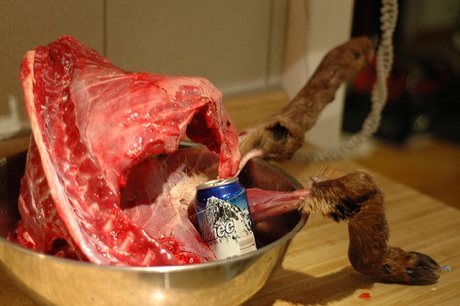
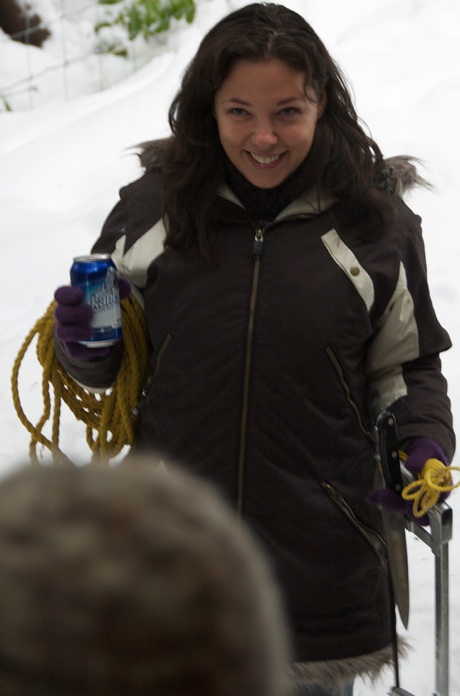
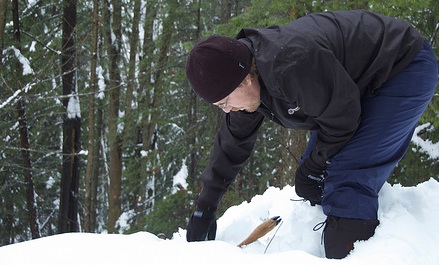
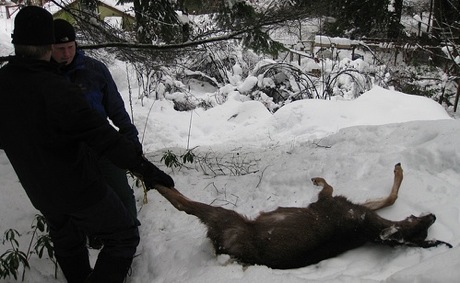
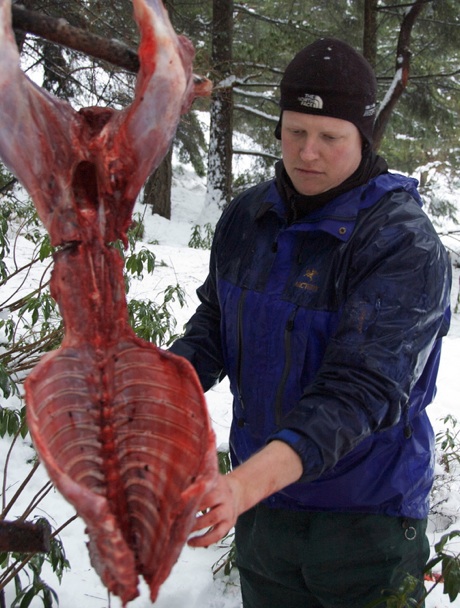
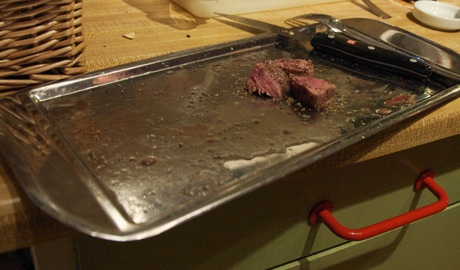
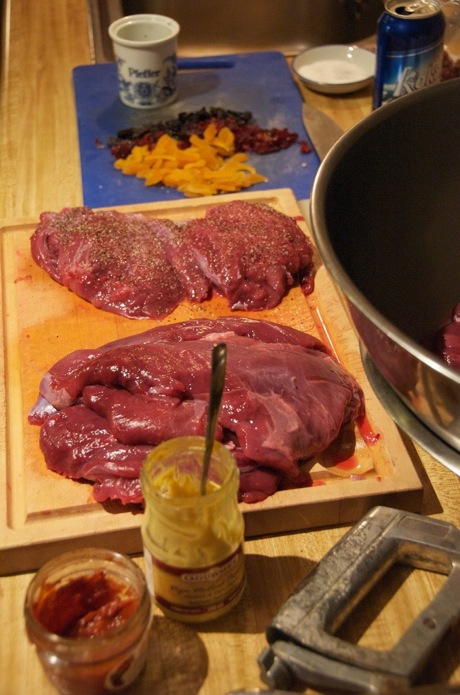
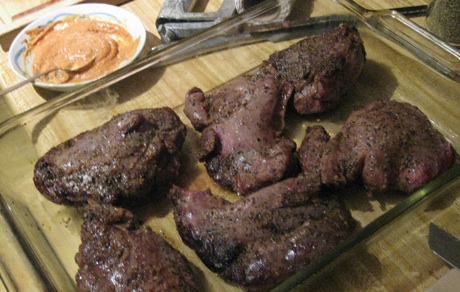
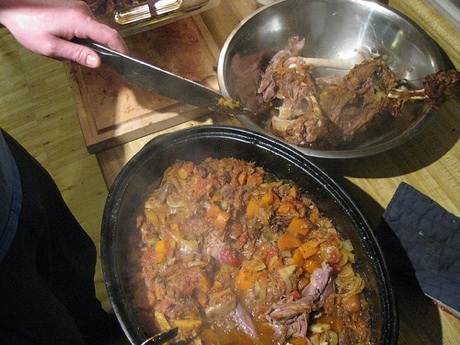
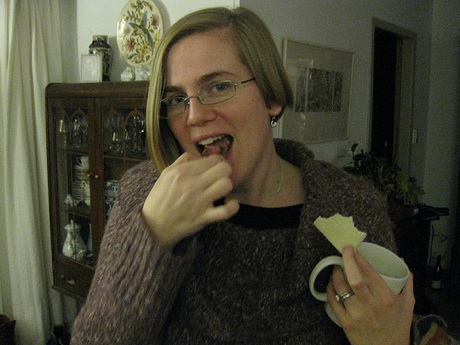

Posted on February 11th, 2009
susie gardner says:
this whole experience was amazing, not the least of which was watching the brazenly cool way that james set up cooking and serving up an entire animal. delicious!
Posted on February 11th, 2009
Degan Beley says:
James, not only was that some of the best meat I’ve tasted, but the experience of seeing it go from a fawn into a 4 course venison dinner that fed a room full of people was an experience I won’t soon forget. Nicely done.
Posted on February 11th, 2009
Jason Landry says:
Well done James, but stay away from my cat.
Posted on February 11th, 2009
Todd Smith says:
Cool post James, I thought I was the only one of the “foodists” who knew how to field dress a wild animal. I can honestly say that fawn tenderloin is one of the leanest, most delicious meats you will encounter.
It’s quite unusual to skin, cut, and cook an animal in a single day though…
Posted on February 12th, 2009
James Sherrett says:
Thanks for the kind words, folks. It was an experience I won’t soon forget either.
Jason: I think we can both agree your cat is nothing like a fawn.
Todd: We’ll have to parlay sometime about wild game.
Posted on February 12th, 2009
Glenn says:
Poor little guy! I wonder what happened to his mother? I wonder if he would have survived if he hadn’t been fed apples by someone? Not a good idea to feed wildlife, especially young ones. It messes up their instincts and skills they need for survival.
Posted on February 12th, 2009
Jordan says:
I for one am glad that although the little guy suffered an unfortunate fate, it was not in vain.
It’s refreshing to know that such skills and traditions are still alive and well. In the event of unexpected dark ages or holocaust, I’m huddling close to James.
Posted on February 12th, 2009
Ben Garfinkel says:
Um, “Someone brought a hoof with them and knocked on the patio door with it.” Brilliant. Also, why the hell wasn’t I invited Boris?
Posted on February 12th, 2009
Boris Mann says:
That would be me with the hoof. It was an open house that kind of … morphed … into this strange fawn-based cookathon. Annual event, everyone invited next year between Xmas and New Years.
Posted on February 13th, 2009
degan says:
ok, but you’re going to have to find a way for another one to freeze next year. think you can do it?
Posted on February 13th, 2009
Boris Mann says:
@degan — simple, I’ll get my mom on that whole apple feeding operation. James and I will rig up some sort of deadfall trip. Simple!
Posted on February 16th, 2009
Degan Beley says:
excellent!
Posted on February 22nd, 2009
Jacob says:
Eating an animal that you you found dead is potentially very dangerous. You don’t know why that fawn was weak enough to succumb to the weather. Granted in this case it was probably because of the ignorant acts of the woman that fed the animal during the fall. None the less though it’s still a pretty stupid idea to eat an animal that might have died because of some underlying medical condition.
Posted on February 23rd, 2009
James says:
Hi Jacob: making generalizations in the comments of a blog post is potentially very dangerous. Don’t be such a twit, please.
Posted on March 10th, 2009
Bubba Gump says:
Howdy Yanks,
I’ve always wondered how a fawn would taste. We have so many down in Texas that they’re a nuisance but with a fancy new french name they make a fine addition to the menu at some of our local wild game restaurants. Sounds like you guys really know how to enjoy your food too!
Posted on April 1st, 2009
gcrazy8 says:
just and fyi you should check you local hunting regulations for your area. You have most likely broken a law in your area and by posting this with your picture means that some pencil pushing dolt in some office is looking at you as another notch in their belt of offenders. If I were you I would have done the same, (why waste it) but I would not leave all the evidence on the internet for any crack pot to see. You may have put yourself on a hit list, animal activists are not always nice and polite. Many areas have laws against picking up dead animal some with huge fines. eg eagle feathers
Posted on April 1st, 2009
James Sherrett says:
@gcrazy8 Thanks for the note and warning. The Conservation Officers I’ve met before have always been good folks, but I understand your warning.
I’ll have a look into the rules and regulations. I don’t think I’ll change the post until I know we’re at risk, but thanks for the concern.
Posted on February 28th, 2010
Joe says:
You know, I have to agree with gcrazy: you may have broken a law or two by doing this. However, 80 years ago (even 50 years ago) I’m quite sure that your local game wardens would have turned a blind eye.
Funny how things change due to a few bad apples.
Posted on April 25th, 2010
Fair Hunter says:
I probably would have done the same. Sounds super good, but I agree with gcrazy as well. I kept thinking while I was reading this that, “this guy is an idiot” for even documenting any of this because it is against the law. Especially when you say that you have plans to do it again in the future.
Posted on December 16th, 2014
Mark says:
My wife and I just found a 5-6 month old fawn dead on Sunday, we think from the major storm which caught it in a flash flood. This is the most tender meat we have ever eaten!